Taking cuttings from monstera deliciosa (other wise known as Swiss Cheese plants) is a cost effective way of getting plants for free. The best monstera have huge notched leaves and these only come with age. If you’ve got access to a large leaved plant of a friend or relative, and they’re willing to give you a cutting, this will be the best way of getting a big leaved plant without having to break the bank. Any plant can be used as source material for cuttings though and even a relatively cheap shop-bought small plant can give you the opportunity to create some new plants for free.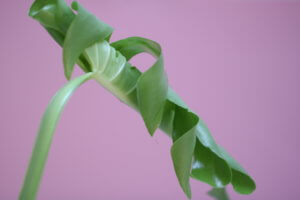
Monstera deliciosa as houseplants
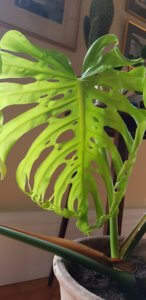 Monstera hail from the tropics of South America and are extremely popular houseplants. Coping well with the dry environment of centrally heated homes, and putting up with a bit of neglect and irregular watering, it is little surprise they’re so popular.
Monstera hail from the tropics of South America and are extremely popular houseplants. Coping well with the dry environment of centrally heated homes, and putting up with a bit of neglect and irregular watering, it is little surprise they’re so popular.
Of course the glossy green leaves, heavily notched with holes and gashes only add to their appeal and there’s nothing more exciting than seeing a huge new leaf unfurl from the stem of a mature plant.
Monstera cuttings from a family heirloom
My large leaved monsteras are all babies taken from a 50 year old parent plant – a family heirloom. The plant grew in the corner of my parents’ dining room and my mother liked to tell the story of how she fed it excess blood taken from her as part of scientific research at Oxford University. Such feeding regimes would be impossible now but who knows – in the the 70s it may well have been a thing?!
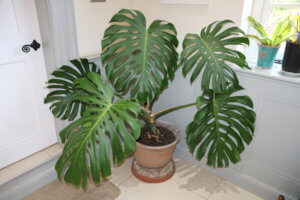
One of my Monstera plants, with amazing broad leaves, was grown from a large cutting taken from a 50 year old family heirloom plant.
Moving with the family from Oxford to Sheffield, and then with my brother to London when my mother died, the family monstera grew to monstrous proportions. When my brother sold his house in London he suggested that I come and get the monstera. By then it had been growing in the ground in the corner of a conservatory for 15 years and was too big to dig up and certainly too big for my car. I breathed in deeply, borrowed his secateurs and took some huge cuttings, unsure if they would root. They all did.
How to take cuttings
My foray into taking monstrously sized monstera cuttings shows just how easy it is. Not only do cuttings root easily in water but also directly into compost. The aerial roots which you see developing at the side of each leaf node are used to search out material to root into for support and sustenance in the forests, where monsteras are natural epiphytes – using larger trees as hosts. When an aerial root hits the ground it will also develop proper roots too. So strictly speaking the monstera is classified as a hemiepiphyte as it will root in the ground as well as in host trees.
Take a look at this YouTube clip, where I show an example of where an aerial root has grounded, where to make your cut and how to root in soil or water if you prefer. If you prefer you can also read below how to go about taking your cuttings. Each of the cuttings shown in the footage is now a healthy houseplant decorating my kitchen or sitting room.
Where to make your cut
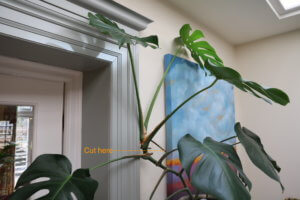
Picture showing where you could take a successful cutting on this large Monstera. Cut below the leaf node (where the stem is slightly swollen). This section of plant also has an aerial that will take root when in soil.
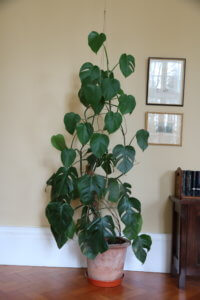 The picture above shows a fairly large plant and where, if you chose to, you could take a cutting. Leaf nodes are swellings in the stem and tend also to have aerial roots forming at these points. These nodes are where there will be a concentration of the hormone called auxins which stimulate rooting.
The picture above shows a fairly large plant and where, if you chose to, you could take a cutting. Leaf nodes are swellings in the stem and tend also to have aerial roots forming at these points. These nodes are where there will be a concentration of the hormone called auxins which stimulate rooting.
The picture on the left shows a younger plant with numerous stems climbing up a string. The plant has many individual sections which could be used for cuttings if desired. This plant is the one featured in the YouTube video above and shows how a plant can bounce back from having cuttings taken from it. New stems develop from just below where the cutting was taken.
Rooting into water
This method is good for smaller cuttings and will suit the curious control freaks amongst us, as you can check regularly to spot root development. Cut a stem below a leaf node and put your cutting into a glass of clean water. Change the water regularly and watch and wait for the roots to form. It’s possible to take the cutting with some aerial root attached and also without. The two pictures below show the roots that have developed after 4-6 weeks in a glass of water, one from an aerial root, the other directly from a leaf node where in time an aerial root would have developed.
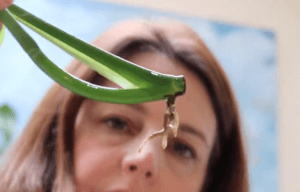
Roots developing from a cutting without established aerials. The roots are appearing level with the leaf node, just above where the material was cut from the parent plant.
Rooting into compost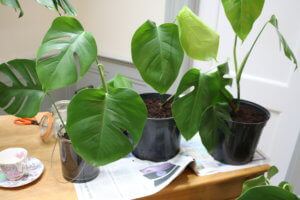
The method for creating your cutting is exactly the same as with water but instead you place the cutting directly into a pot of compost and keep it moist but not waterlogged. The roots will develop in the same way as in water but you are denied the opportunity to check on the development of the roots. You will know that it has worked as the plant will start to thrive, throw out new leaves and – the biggest test that a cutting as worked – the plant won’t wither and die!
Cuttings from large plants
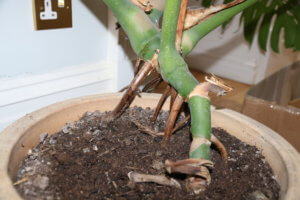
This picture shows how the aerial roots potted up with a monstera cutting taken from a large plant have helped to stabilise the plant and root quickly.
I would argue against rooting into water for a very large cutting as you would need a large bucket or tub! Also, placing the cutting into soil will provide it some stablility as you wait for it to root.
Taking the cutting is identical to smaller plants, you need to identify a node and cut below this. Before making your cut, take a look at the parent plant and assess the impact on its appearance of removing your chosen material. Don’t worry too much though as the plant should recover and can regenerate from the point you take the cutting.
When I took my large plant cuttings, I chose nodes with aerial roots already emerging and when I potted up the cutting I placed it, aerial roots and all, into the pot. These will have sent out ground roots into the soil. I don’t know how long my large plant cuttings took to root but the first new leaf came on one a few months after potting up.
Good luck with your monstera cuttings – I hope you have the confidence to try!
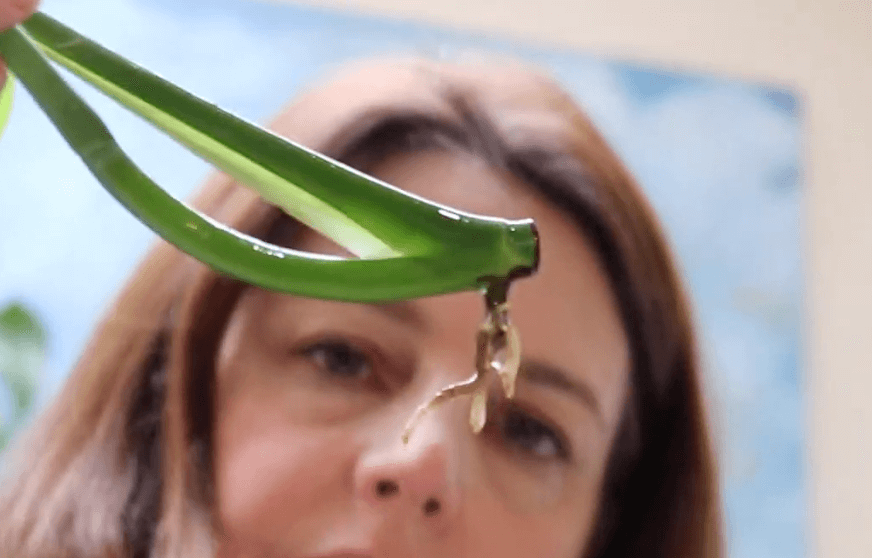
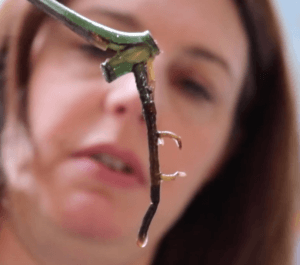
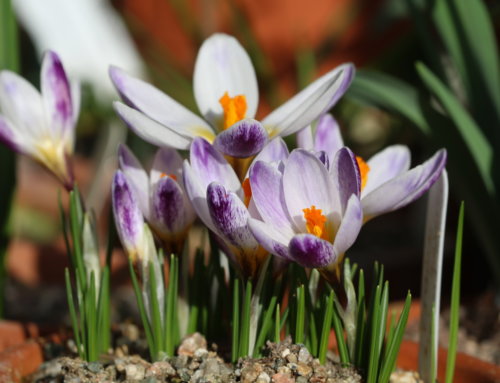
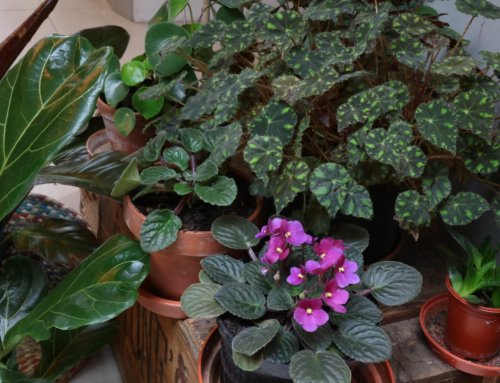
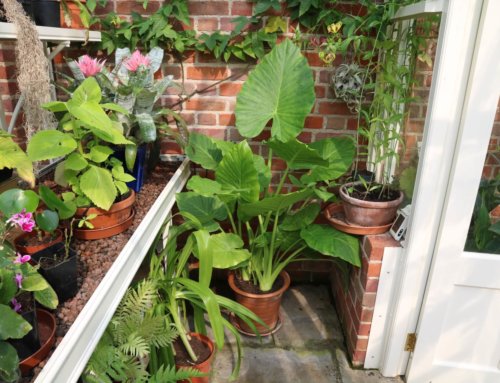
Can I propagate the ariel root straight back into the main pot? As in, cut it then plant it into the main pot to make my current monsters fuller?
Thankyou
If you let it grow down so it roots into the soil of its own accord it will likely then grow new leaves from there. That would be less risky than than cutting and potting it. I find the aerial roots grow quickly and will soon reach the soil in you pot if left unchecked. I don’t know if you’ve seen the YouTube clip embedded in the blog but if you do I’ve shown an example of where the aerial has rooted and a new leaf sprung up at soil level. Good luck!
New monstera mom here. I purchased a root cutting and the seller said one of the ends of the cutting has been treated with growth hormones. Do I leave it lying on a pot with soil and wait for an aerial root to come out so I will know which end to stick in the ground or can I randomly stick any which end of the cutting in the soil and expect aerial roots to grow from there?
Hi Melanie – have you been given a piece of root or is there a stem and leaves attached? If you want to email me a picture or tag me in a social media post then I’d be happy to take a look (see my contact page for details).
Im propagating my beautiful monstera its been in water for 3 weeks now and the node has grown 6 inches but roots are not growing. Is it ready to plant? Does it need actual roots or is the node a giant root?
It will need roots eventually but seem to be coping for now without. The roots should grow from the node. You have a choice as to whether to wait longer with it in the water and watch for the roots to develop or to pot it up. Either way I would think the roots will develop soon. Good luck!
Hi. I bought a couple of monstera stems, one with two leaves and the other has three and both have air roots. I potted them right away in a soil. It has now been 4 days and 1 or two leaves looks like they are drooping, is that normal or is there a problem?
Thanks.
Hi Chris, a bit of drooping is to be expected as the plant has no way to take in sufficient water until more roots develop. Keep the soil moist but not too damp. Ideally keep the plant in a fairly cool humid environment if you can. A warm dry environment increases the transpiration rate of the plant and increases the amount of water it needs to draw in. Don’t panic yet and hopefully before long some roots will develop.
I have a Monstera cutting I’m trying to propagate in water that has an aerial root but no node.
Am I wasting my time?
I have had roots develop from the aerial root so no, I think you should be fine.
Thank you for this really helpful post, the video is great. I’ve just put a large and a small cutting into two pots of compost. How long should they sit in a saucer of water? And should they have plant food at any point? Thank you!
You need to keep the compost moist but not waterlogged so they can sit in a saucer of water but not permanently. Just keep an eye on how much water is absorbed by the compost. They won’t need feeding until you’re sure the roots have developed and the plant is growing. I try to feed mine every week with a dilute houseplant food. Good luck!
Just wanted to say thank you for your excellent guide on taking monstera cuttings and the advice you gave me above- my little one has sprouted two leaves, and I gave a large cutting to a friend- she is THRILLED as it’s growing like anything and also has two new big leaves! Thank you again
I’m so pleased it’s worked out Laura and that your friend has one too. Spreading the Monstera love!
Hello! I am a new monstera mom. I just bought a cutting from my neighbor, can you suggest which method should I use for rooting? The cutting is huge tho.
Hi Machel. If it’s big I would definitely root into compost to keep it stable. The water method is interesting as you can watch for the root development but my large cutting rooted beautifully into a large pot of compost. Wishing you all the best for your cutting.
I made a mistake ! I cut the leaf stem off before I knew I had to have a root node. Do you think it will root ? I just did it today before I saw your site.
I would say it’s unlikely but my view in cases like this is that you’ve made the cut so why not try and see what happens. You’ve got nothing to lose after all!
Thanks for this guide, I have a variegated monstera. The bottom of the stem had some rot so I cut it up further and put it in water there is now an aerial root from the side but the bottom still hasn’t yet rooted. Should I put it all in soil or leave in water ? I’m concerned about the bottom not having growth but aerial root looks great.
Hi Rachel, my experience is that roots will appear on the aerial root in water or in soil. If an aerial is present, the cutting will choose to root from the aerial not from the base of the stem so since the aerial is looking good that’s reason to be optimistic. The rot on the base of the stem was a bit concerning so you did right to cut it off.
Hi! I love your guide and look forward to making a cutting of my own swiss cheese plant when it’s more mature; I wonder, however, if you have any advice on flies? My CSP is about 6 months old (having got a cutting online, which is now thriving), but it does attract a lot of tiny flies. Is there a way to eliminate these critters entirely?
I think the flies are probably fungus gnats. I get many of these too. They burrow into the soil to lay eggs. I have found them easy to control by buying yellow sticky pads. I cut them into small sizes and place them at the side of the pots between the plant and the closest light source (eg window light). The gnats are attracted to the backlit yellow and fly into it and get stuck. It’s a bit gruesome but very effective.
Ahh yeah, I brought this pretty butterfly yellow sticky paper which is really getting them. They never truly go away though, which is a shame, but at least it keeps them in control. Thank you 😀
Sounds like you’re doing all you can Jonathan without resorting to chemicals, which I personally don’t like to use. You’re right they never really go away but in the UK they’re pretty seasonal, worse in spring and early summer.
Hi! I have my mother’s large (very old) plant that I thought was a swissh cheese plant but maybe actually philodendron bipinnatifidum. The pant is not a climber like the monstera above, it just has 2 main stems, from 2 separate plants it seems, with many leaves and aerial roots. To cut the stem would be to take the whole body of the plant as there its only one stem each. Do you know a way to get a leaf cutting? One just snapped off as I poked around so I have put that in water in the hopes that maybe it will, but I dont feel hopeful as it is just a snapped leaf without a root attached.
Thank you for any help you are able to give. Your above plants are beautiful and so lovely you managed to keep the family heirloom alive 🙂
Hi Effie – it’s lovely for you to have a family heirloom. It would be useful to see a photo to be sure of the ID. I do have a philodendron bipinnatifolium and it doesn’t have aerial roots although I know the big old ones like your mum’s can have. They can propagate in water if the leaf snapped off near a so it’s worth a go as you have done. Thee other option I’ve read about is air layering. Good luck. I’m really rooting for your cutting.
Hi there: about 3 weeks ago I put a cheese plant cutting (with one node) in water in the hopes of it rooting, but as of yet noting seems to be happening? The 3 leaves on my cutting are still very healthy and thriving, but no roots – any ideas? Should I just give up and try again? It seems such a shame to give up on it especially as the leaves look so healthy!
Any help would be really appreciated!
Thank you 😊
Definitely don’t give up. It can take a month or sometimes longer for the roots to develop and if the leaves still look healthy what have you got to lose by waiting longer. Good luck and I’m willing you success!
Fantastic advice – thank you very much!
Thanks Hugh – I’m glad you found it helpful and good luck with your cuttings.
How long would you recommend letting the cutting root in water before planting? I was given two about a month ago that had already began to root, and the roots are several inches long now. Are they good to transfer to soil, or should I continue to wait?
Hi Elizabeth – once you have roots I’d pot it on into compost. The water has no nutrients but compost does. Keep the compost moist of course. Glad you’ve had rooting success – it’s always an exciting moment.
Hey there! I took a cutting from my neighbor and it was cutted right below the leaves and it has a thick node but, has no aerial roots; will it still propagate and grow like it’s mother plant??????
Yes, if it was cut below a leaf node it should root fine. If you look on the blog post you can see pictures of me holding up two rooted cuttings. The first of the two pictures shows one that was cut below the leaf node like you’ve described. I rooted this in a jar of water and the roots developed after 4-6 weeks. Good luck!
Hi – my monstera has outgrown it’s pot! Which soil can I use when re-potting? I’ve been looking online and there are a lot of suggestions for mixing 4 different types. Do I need to buy 4 different types or can I purchase 1? Don’t want to harm my monstera but also don’t want to break the bank – Thanks, Kate
I tend to just use peat free multipurpose compost for my houseplants. I’m sure more expert growers have developed good mixes but as you say there’s a major outlay for a hobby grower. The thing with houseplants is that they will be in the same compost in their pot for quite a while. They will use up the nutrients available, whatever the compost you use. I would therefore recommend a regular liquid feed (I usually use baby bio but others area available). If you do this I’d say you can worry less about the compost.
Hi
I have a cutting of the two leaves and the nod from a friend. It’s been a month since it’s sitting in water, and there isn’t any change to it. No roots no aerial roots.
The leaves look healthy though.
Is it okay if I can just pot it with some soil, cocopeat?
It should root fine in the soil but I’d be tempted to leave it a bit longer in the water and pot it up once roots appear. I do this as I think the cutting stays just a little more hydrated in water and you can keep an eye out for roots and feel confident when you see them. That’s not to say that roots won’t appear if you pot it up now but you may start wondering what’s going on under the soil and start digging around out of curiosity. Whatever you decide I really hope you have a lovely healthy plant soon.
My cuttings have been in water for 2 months now and have roots ( mainly from Ariel roots). When should I pot them up?
That’s great news – as the roots have developed then you can pot it up now. There are no nutrients in the water so potting it up should give it a nice boost.
Hi! I cut my Monstera adansonii with small aerial roots and put them in water to grow more roots and transfer them in soil. It’s been 4 weeks now and no new root formed, while the small aerial roots begun to rot and the leaves yellowed and fell . The nodes are still not rotted and some leave still okay. but do i put them in soil while the other aerial roots are not rotted yet?
Hi MJ. I’ve not experienced rotted roots in water before. Maybe the ones that rotted were damaged already and so it was easy for rot to set in? I think I would be tempted to pot them in compost as they should root there and are less likely to rot. It’s just hard to know what’s going on under the soil! Keeping my fingers crossed for your plant.
Hi, thanks for the really helpful post and your attention to comments! I have taken two cuttings from the top of my monsters which already had roots at the node and popped them in water. I’m feeling reassured that should act as a good insurance policy against what I then did with the rest of the plant… it had got really leggy and a lot of leaves got damaged when I moved home, first the movers put it next to a turned on radiator and then they dragged it around tearing most of the leaves 🙁 I gave it quite a severe haircut, taking the three main stems right down to one or two leaves high, in the hope it may rejuvenate it a little. Can you save me any of the agonising wait to see what happens?!
Hi Claire, my experience is that they recover well and new shoots spring from the nodes below any cut. It may take a bit of time but I don’t see why it wouldn’t recover. Good luck!
Hi, I was recently gifted a Monstera albo with one very small aerial root that is mushy and black, the bottom of the stem was also black and started to spread. I cut off the bottom and have left it to callous over but I’m not sure what to do about the root. If I cut it off and apply rooting powder will more grow?
Thanks for your help
Hi Anna, it sounds like you did well to act quickly and stop the rot. I’ve not seen rotten roots and stems before but if the root is all mushy I’d definitely cut it off. I’ve had cuttings root from the leaf node without any aerial roots attached so this is your best bet. Given you’ve had rot already, I would try rooting the cutting into compost rather than water and fingers crossed roots will grow from the calloused node. If you have rooting powder then I would try some of this on the node too as the powders usually contain fungicides and other chemicals that should reduce the chances of rot. Good luck!
New monstera mam here. I’ve been given 3 small cuttings. I’ve had them in water since end of nov. There are no signs of roots growing nor have the leaves started to decay or wilt. Do I just preserve with what I’m doing or is there something I’m doing wrong?
Hi Katie, I can’t see that you’re doing anything wrong and as long as the leaves and stems are OK there’s reason to be optimistic that eventually roots will grow. I’m just wondering, were the cuts made below a leaf node as that’s where the roots should grow from?
Yes, there are two nodes on each cutting. The leaves are now starting to deteriorate on one of the cuttings so starting to think it’s not going to happen now
Katie – you never know, it could still happen. I’m willing them to root for you!
Hello! I never post on sites normally but really wanted to say thanks for a great piece about the Swiss Cheese plant! I have had mine for 21 years and it is a beaut, but I am so excited now knowing I can make MORE!! I am also really excited to see what it might look like in another 20 years. Thanks again.
Hi Kate, thank-you for taking the time to get in touch and for giving such lovely feedback. Good luck taking cuttings from your lovely old plant. It’s a bit nerve wracking to try but it is worth it if you want more plants. Best wishes.
Hi I’m a new monstera owner I after reading this post went ahead and got a cutting from an old monstera growing near my home I ve put it in soil so the no of leaves affect the growth and also I’ve got a cutting with just stem node and a leaf bud on it will it take roots plz guide
I can’t see why this wouldn’t root if you’ve taken then cutting with a leaf node. Keep in touch and let me know how it goes.
Hi Katharine
I have a very leggy 6ft tall plant made up of 4 stems up a moss stick. The bottom 1/3rd leaves are torn, brown or missing thanks to our kids. You brilliantly show how to create a new plant taking a cutting from the top.
If you could imagine cutting the plant in thirds with the top third becoming a new fresh looking plant. As you have shown.
Would the next third down take to becoming a new plant in the same way?
Finally what is best way to deal with the bottom third still in the pot? Would I expect new leaves to form from the bottom or am I best cutting it back hard almost to the soil level and letting it try again. (After all the bottom leaves wouldn’t be saved in the long term as they look so trashed)?
I also have rooting powder is this an opportunity to make dozens of plants?
Thank you for your time and help.
I David, sorry it’s taken me a few days to respond. If you cut the top third as cuttings then the middle third will start to regenerate from the closest leaf node to where you cut. I have done this so many times and I can assure you that they will bud new leaves. With the lower third I would cut off the damaged leaves. They will probably not sprout from these lower nodes as the plant will automatically put its effort higher up. It is a climber you see. Sometimes new shoots come from the base, or if you get lots of rooted cuttings you could plant a couple at the base to cover the lower bare areas. Good luck and yes, the rooting powder should help the cuttings to root. Good luck!
Could you please give me a specific organic plant food for my Swiss Cheese. She’s new and I want to do everything right. Also when adding a moss pole I suppose I need to put it in a new pot. What kind of soil please.
Hi Gail, thanks for getting in touch. I don’t use a specific plant food, just a general liquid feed such as baby bio. In terms of soil, I just use normal multi-purpose compost. Remember that over time it will use up all the nutrients so feeding can be useful. Also – I know you’re keen to do everything right but I have found that swiss cheese plants are very tough and don’t need molly-coddling. They’re used to fending for themselves up in trees.
Hi! Thank you for the brilliant video! I received a cutting of a Monstera Albo in the mail yesterday and it has one aerial root and two long dark soil roots – i put it in water and overnight the bottom of the stem went a bit mushy so I cut it off in case it was root rot. I’ve switched the cutting to perlite now and tried to keep the humidity between 80-90%. I was wondering if I should transfer it straight to soil? Or keep it in perlite for a while to encourage more root growth? I can’t find any videos on YouTube explaining what to do with soil roots rather than aerial roots. Thank you!
Hi Simi – My instinct is always to pot things up once ground roots appear. It’ll help to stabilise the plant, and give it some nutrients too. I just use normal compost for mine and don’t bother with grit or perlite. Good luck – it sounds like you’ve got a lovely plant there.
I was given a monstera cutting that already had one root a few inches long and another one that started sprouting. I decided to wait to plant it until the smaller root grew a little longer, but the longer root (growing from lower node) broke off today. The smaller root (growing from the upper node) is still intact and about 1.5 inches long. Should I plant or keep it in water?
Hi Rachel – I’d pot it up. Water is fine for keeping it alive for a while and promoting rooting but sooner or later the plant will benefit from the nutrients on soil or compost.
This is so handy and so detailed, thank you so much! I’ve had my monster for about three years now and taken multiple cutting for family and friends. I’ve kept the very first cutting for myself and after a bumpy start it has the most mature looking leaves both in size of nodes and leaves as well as fenestration – it has the typical secondary holes.
Just today, I did a big chop on my mother plant which are actually three plants growing in one pot with a moss pole, since it was growing dangerously top-heavy and just looked messy from all the cuts and new growth of the last years.
The question I now have is whether the maturity of my plant is developing from the ground up from the roots or can I see the level of maturity purely by looking at leave sizes and level of fenestration?
I’m wondering if I should really prune heavily or just keep on growing (and maybe reinserting) the more fenestrated head cuttings?
Hello from Canada. Thank you for post amd video. Its really helpful. Ive decided not to cut a piece off and allow ariel roots to root in soil to make plant fuller. Thebarielnrpots are quite large already. Im am wondering if you could show how you got the plant to grow up the string. Is the string from ceiling?!
Hi Wendy,
Yes it’s growing up a string tied to a nail on a beam. I either tuck the stems round eachother as they grow or tie them to the main string with more string! Sadly, I’ve just had to move it to another room as I got kittens who like to climb it!
🙄 sorry for typos..lol..I really should get glasses and check before sending 🤓
Hi there. I want to propagate my year old cheese plant, so I intend to take a cutting from it to make it into a new plant, but would the stem of the original grow back after cutting below the node on my original plant,.or would I need to cut down to just above the next node down?
Hi Jayden – yes you should cut it back to just above the next node. New stems should shoot from this node. Sometimes it takes a little while so be patient. Good luck!
Yay! Thank you, I will do this then.
Hi there, I have come to own a relatively well established plant with three big leaves. The stems come straight out of the soil. Is there any way to try grow more stems or propagate from these? Will there be nodes in the soil?
Hi Liv, occasionally the plant will throw stems up from around the roots but generally new leaves grow out from the stems of the existing leaves. They root so easily from cuttings then the best way to get new plants will be to find suitable cutting material on your existing plant. I hope you give it a go.
Thanks for your lovely feedback. I haven’t written any books but never say never!
[…] monstera albo cutting can be rooted in water or soil, but the best way to do it’s by using water. You can take the cutting from the parent plant […]
Hi, thank you for the wonderful acticle, it did helped me a lot to understand the propagation of monstera.
I got only one leaf with the node and I kept it in water. Atrer 5 weeks it started rooting and when the root was about 2 inches long I had put it in the soil.
However, the issue is that the leaf stared to vilt and developing transparent yellowish colour.
In short, I’m afraid it will die before it developers a new growth.
What do you suggest to do? Should I maybe cut the leaf and leave only the part where new leaf should grow out?
Many thanks in advance!
Mateja
Hi Mateja, That’s a real shame – these cuttings are usually very robust but your leaf obviously wasn’t getting what it needed in time. Personally, I would leave the leaf on and hope the roots develop enough to support the new one in time. I really hope it works but if not do try and again!
Hi Katharine, I might have done a massive mistake by cutting aerial roots before cutting the stem of an established plant for propagation purposes. Now I am left with 10 or so big leaves on stem cuttings, but the problem is that almost all of those have a cut-off aerial. I am wondering if this would result in all of those cuttings rotting eventually.
Hi Elena,
I have rooted cuttings without aerial roots so it’s definitely worth a try. Good luck!